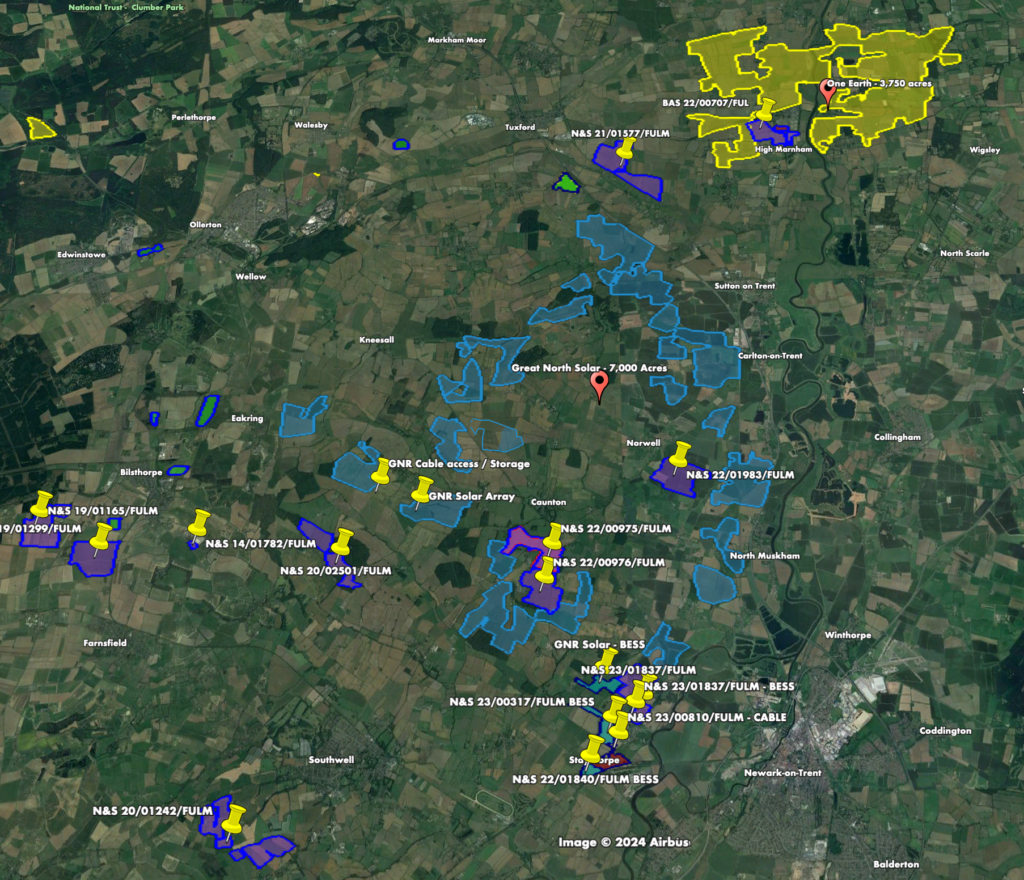Scrutinising Solar
Newark & Sherwood Solar Action Group
Farmland for Food, Rooftops for Solar

CUMLATIVE IMPACT
Newark and Sherwood already hosts over 600 acres of ground mounted solar facilities and it now faces unprecedented proposals for solar development which will fundamentally alter the character of the area for a generation.
In total there are over 10,000 acres of planning applications:
- 7,000 acres – Great North Road Solar Park Blue Outline
- 3,750 acres – One Earth Solar Farm Yellow Outline
- 200 acres – Foxholes Solar N&S 22/01983
- 200 acres – Kelham Solar N&S 23/01837
- 200 acres – Cotmoor Lane N&S 20/01242
- 200 acres – Winkburn Solar N&S 20/02501
- 200 acres – Inkersall Solar N&S 19/01165,
- 200 acres – Knapthorpe Solar N&S 22/00976, N&S/00975
- 200 acres – Muskham Solar
- Battery Storage – Staythorpe N&S 22/01840, N&S23/00810
Our Aim
We are a local campaign group committed to the advancement of renewable energy. However, we advocate for prioritising the installation of solar panels on rooftops to preserve farmland for food production.
Should ground-mounted solar installations become necessary, only those schemes that minimally impact the environment, maintain food security, and garner community support should be considered.
Villages affected: Newton on Trent, North Clifton, South Clifton, Egmanton, Moorhouse, Ossington, Norwell, Norwell Woodhouse, Carlton on Trent, Cromwell, North Muskham, Bathley, Little Carlton, South Muskham, Kelham, Caunton, Maplebeck, Kersall, Eakring plus others
It affects over 10,000 people across multiple parishes within the District.

“The largest and most egregious thus far is the so called Great North Road Solar Farm. It is a scheme of breathtaking scale. It would be a massive change to the landscape of the area, turning beautiful countryside into an industrial landscape and loses hundreds of acres of agricultural land. This is not a reasonable proposal. It is completely out of control and must be stopped.”
Rt Hon Robert Jenrick, MP for Newark
The Key Issues
Sheer Scale
Loss of Habitat
Loss of Amenity
Visual Impact
Traffic Impact
Safety Concern
Sourcing Concerns
Loss of Productive Land
Increased Flood Risk
ShEEr Scale
In a District of 160,000 acres the various solar developments will consume 6% of the total land fundamentally altering our rural landscape for a generation. The proposals combined will consume as much land as Heathrow, Gatwick, Stansted and Manchester airports COMBINED!
15 miles across and 15 miles north to south, the District will be unrecognisable if the proposals are approved in this density.
The clustering of such volumes of solar development in the region is unreasonable.
Loss of Productive Agricultural Land
There is a clear policy conflict within government which seeks to protect and enhance our domestic production to maintain food security, yet it is encouraging the growth of renewable energy on valuable productive farmland. We are concerned about this considerable loss of land and inadequate policies to protect it, particularly in the light of the Russia/Ukraine war and the impact it is having with global food shortages and food prices. Government policy through the National Planning Policy Framework (NPPF) and draft National Policy for Energy EN3 is clear that ground mounted solar should use previously developed land, contaminated land, industrial land and agricultural land of grade 3c, 4 and 5, not Best and Most Versatile (BMV) land of grade 1,2 3a and 3b.
DEFRA identify that the UK is only 62% self-sufficient in food (gov.uk figures). This array aims to cover 12% of Newark and Sherwood’s productive land, (some of the best in the UK) but which ironically, is not a particularly good area of the country for capturing solar irradiation (52oN).
“Labour recognises that food security is national security.” They commit to “introduce a land-use framework and make environment land management schemes work for farmers and nature. ” This array does not sit well with such aims, particularly when credible alternatives exist for pv location.
We believe that no large scale solar plant should be approved for development on greenfield land until the collective impact on the environment, biodiversity and food security is fully understood.
Labour believe that “The national grid has become the single biggest obstacle to the deployment of cheap, clean power generation and the electrification of industry.” Placing solar panels on domestic properties rather than solar farms would place production at the point of use, reducing the stress on distribution.
Solar panels should be erected on brownfield sites, all new housing and all commercial buildings. Using productive agricultural land should be an absolute last resort.
Visual Impact
Imagine solar panels mounted up to 3.3m high spread across 10,000+ acre site of open countryside adjacent to many local villages. There will also be 2m high security fencing, CCTV and security lighting to 3.5m around the solar panel fields. Added to that will be inverters and transformers dotted across the site in large unsightly containers emitting significant and constant noise. Given the unsightly nature of this industrial landscape and minimum noise requirements, solar developers have to take appropriate mitigation measures. Many of the so-called screening enhancements will take up to 15 years and beyond to provide a decent level of screening, but this misses the point as the character and beauty of much of this countryside is the long lightly undulating open vista.
Solar panels up to 3.3m high across 10,000+ acre site of open countryside.
Loss of Social Amenity
Mental health challenges faced by those living and working in rural communities has been identified as a key priority for the Government and NHS, yet no consideration has been given to the loss and diversion of footpaths or the visual beauty that are so beneficial. Rural pursuits of walking, cycling, riding or driving through the countryside, and experiencing the health and well-being that brings to us (something that has proved to be so important during Covid) , will be significantly impacted by being surrounded on public rights of way and quiet country roads by solar panels invertors and battery storage plants. Note public rights of way are likely be moved or closed during the construction phase, which could have a significant impact on all users. These changes can be made permanent without any recourse to local planning.
Public rights of way will be moved or closed during and after the construction phase.
Residential Amenity
Our homes are our sanctuaries, offering peace, privacy, and beautiful views that define life in Nottinghamshire. But the proposed solar developments threatens to destroy this by surrounding our properties with a sea of industrial panels.
Developers, driven by profit, are willing to place these panels alarmingly close to our homes, ignoring the impact on our community. This isn’t just about losing a view—it’s about the real consequences: devalued properties and diminished quality of life.
When our visual amenity is compromised, so too are our house values. Buyers are less interested in homes overshadowed by solar farms, and those who do buy will likely pay less. Over time, this could lead to a significant drop in property values, affecting our community’s prosperity.
The emotional toll is equally severe. The constant presence of industrial panels can make us feel encroached upon, diminishing our sense of privacy and tranquillity.
.
Flood Risk
The creation of any large scale solar development would increase the flood risk to the local countryside, roads, villages, and outlying properties over a wide area. This area already has a significant flood risk, which such a major construction will inevitably exacerbate.
Laying new tracks and access routes during the construction process to enable the solar panels and fencing to be erected, will cause compaction of the soil across the whole site. During operation ongoing maintenance will cause further compaction to the soil which is already less aerated, reducing the ability to absorb rainwater.
The run-off characteristics of rainwater from solar panels is different to rainwater falling straight to the ground. Rainwater falls evenly over a wide area, the run-off of rainwater from the panels would be in concentrated amounts, like rain running into the gutter of a house. When rainfall is heavy, gutters are deluged with water and overpowered. The same is true for the solar panels except the rain would create water channels/gullies in the soil, causing further compaction of the soil, and ultimately speeding up the run-off from the site into nearby fields, roads, rivers and other vulnerable areas such as some local villages.
The run-off characteristics of rainwater from solar panels is different to rainwater falling straight to the ground .
Traffic Disruption and Damage
The construction phase will take more than 2 years with all HGVs, abnormal loads and workers’ construction traffic coming through or past the outskirts of many local villages. This will create added noise, pollution, and damage to roads and associated verges, as well as extra risk for pedestrians, cyclists and horse-riders. It is also likely to disturb the bio-diversity down more rural side lanes.
The heavy traffic will inevitably cause significant damage to road surfaces, putting extra burden on a hard-pressed council repair force, who’s focus is not on the rural areas.
Some of the roads will be too narrow and will require road widening and many special traffic measures.
Elements Green confirmed at the Ossington Meeting that no money had been set aside for repair of the roads after the inevitably significant road damage after construction.
Battery Storage Safety
Kelham solar and battery storage facility is planned adjacent to Staythorpe power station. Assuming it will happen at some point the batteries will almost certainly be lithium-ion, which have a reputation for being unstable and very dangerous if they develop a fault.
These lithium-ion batteries are usually housed in large containers, stacked up to 13m high. Faults can occur due to mechanical damage, heat, internal short circuits and poor battery management. When a fault occurs it causes a chemical reaction which, unlike normal fires, do not need oxygen to burn and are therefore very difficult to put out. The only way to stop the reaction is to cool it with vast amounts of water, more than is ever likely to be available at the site. The chemical reaction caused when the batteries fail emits large amounts of toxic gas, mainly hydrogen fluoride, after which explosive gases are given off that can cause substantial explosions.
Safety regulations are still woefully inadequate as the system fails to catch up with the speed of battery storage introductions connected to large scale solar applications. Until there is better regulation to protect the potential toxic impact to the environment and residential areas, and better fire protection measures for safety teams, battery storage should not be introduced.
